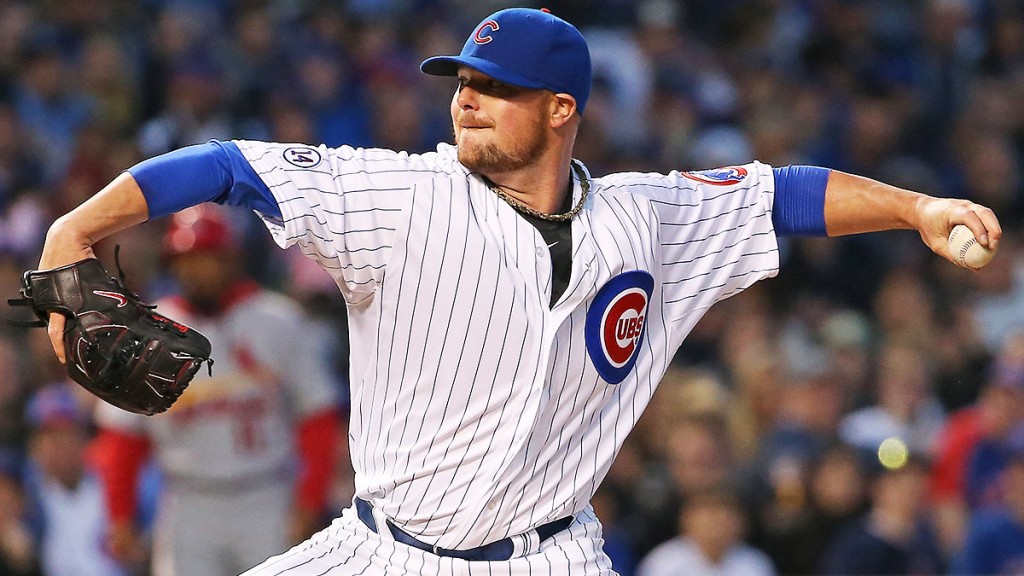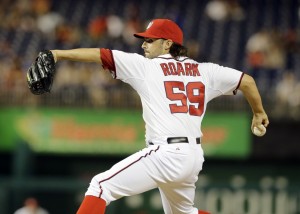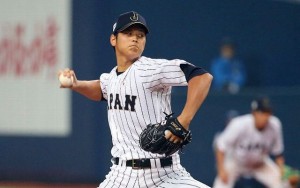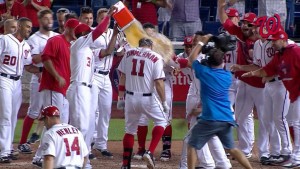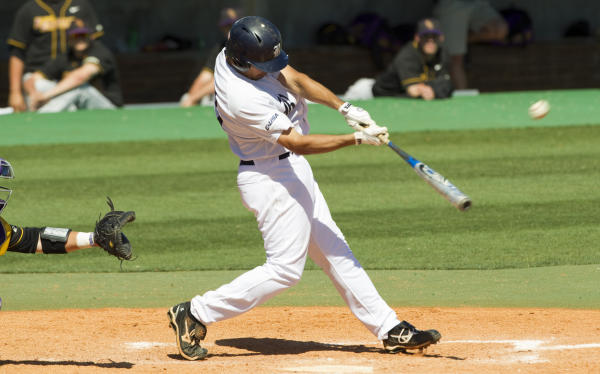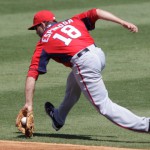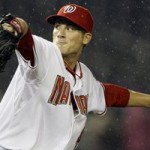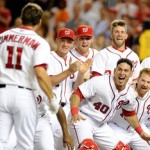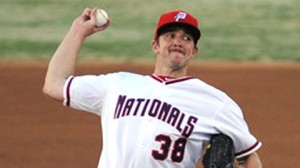
Taylor Hill is one of the younger hurlers in AAA. Photo via milb.com/Potomac Nats official
Age Appropriateness by minor league level is a topic I come back to year after year. Click here for this analysis in 2011, and then here for the same analysis for 2013 (I must have been really busy in April of 2012 to have missed out on such fun analysis).
I won’t repeat a ton of the build-up to this topic; see last year’s post for a ton of rule-of-thumb discussions and what not. Basically the point of this post is to talk about the average/median ages of pitchers in the various full season minor league levels, then take a look at our four full-season affiliate rosters to see how our guys rank. I’m very much of the belief that age matters in prospects, and that it should be taken into consideration when looking at a guy’s performance.
Data Taxonomy: I’ve taken every pitcher on every team’s roster in each of the four leagues that the Nats have farm teams in (AAA = International, AA = Eastern, High-A = Carolina, Low-A = South Atlantic), put them into a spreadsheet, calculated their ages at the end of this season (9/1/14) and then calculated the four quartile figures in terms of age. I only used pitchers in our leagues as opposed to the entire level across all of baseball thinking that different leagues may have different needs (I’m thinking how the California League and the Pacific Coast League has so many hitters parks and thus the pitchers may linger there longer, skewing the numbers). I also standardized the numbers to be at the end of the season as opposed to the beginning, so that people can talk about a player’s “Age 25 season” for example. I’ve labeled the four quartiles as follows: “Really Young” means the lowest quartile or youngest 25% of players, “Young” means the 2nd quartile or 25-50%, “Old” means the 3rd quartile or 50-75% range, and “Really Old” means anyone in the 75th quartile or above for the league.
(Click here for the whole worksheet of player data I used to do this post on Google Docs).
First, a look at how these age rankings have fared over the past few years:
Age Appropriate Matrix 2011-2014
| 2011 |
AAA |
AA |
High-A |
Low-A |
| Really Young |
25.54 or younger |
24.44 or younger |
22.65 or younger |
21.88 or younger |
| Young |
25.54 – 26.93 |
24.44 – 25.37 |
22.65 – 23.83 |
21.88 – 22.84 |
| Old |
26.93 – 28.79 |
25.37 – 26.65 |
23.83 – 24.77 |
22.84 – 23.65 |
| Really Old |
28.79 or older |
26.65 or older |
24.77 or older |
23.65 or older |
|
|
|
|
|
| 2013 |
AAA |
AA |
High-A |
Low-A |
| Really Young |
25.91 or younger |
24.02 or younger |
23.08 or younger |
21.69 or younger |
| Young |
25.92 – 27.75 |
24.02 – 25.17 |
23.08 – 24.00 |
21.69 – 22.66 |
| Old |
27.75 – 30.35 |
25.17 – 26.84 |
24.00 – 24.91 |
22.66 – 23.39 |
| Really Old |
30.35 or older |
26.84 or older |
24.91 or older |
23.39 or older |
|
|
|
|
|
| 2014 |
AAA |
AA |
High-A |
Low-A |
| Really Young |
25.85 or younger |
24.13 or younger |
22.74 or younger |
21.84 or younger |
| Young |
25.86 – 27.47 |
24.14 – 25.27 |
22-74 – 23.63 |
21.84 – 22.65 |
| Old |
27.47 – 29.58 |
25.27 – 26.77 |
23.63 – 24.53 |
22.65 – 23.69 |
| Really Old |
29.58 or older |
26.78 or older |
24.53 or older |
23.70 or older |
|
|
|
|
|
At a high level:
- AAA’s median age has risen from 2011, but 2014’s teams are getting slightly younger; all these threshold ages are slightly below 2013’s numbers.
- AA is more or less the same; the median age only differs by 1/10th of a year from last year
- High A: is getting younger; its threshold ages are all about a half a year or more younger this year
- Low A seems about the same; its median age is identical to last year’s.
Here’s a look at the Nationals’ four full season minor league pitching staffs, with the ages listed and the “age appropriate” label given. All rosters are as of 4/18/14.
AAA Syracuse
| Team |
First Name |
Last Name |
DOB |
Age as of 9/1/14 |
Age Status |
| Syracuse (Wash) |
Aaron |
Barrett |
1/2/1988 |
26.66 |
Young |
| Syracuse (Wash) |
Xavier |
Cedeno |
8/26/1986 |
28.02 |
Old |
| Syracuse (Wash) |
Manny |
Delcarmen |
2/16/1982 |
32.54 |
Really Old |
| Syracuse (Wash) |
Christian |
Garcia |
8/24/1985 |
29.02 |
Old |
| Syracuse (Wash) |
Taylor |
Hill |
3/12/1989 |
25.47 |
Really Young |
| Syracuse (Wash) |
Aaron |
Laffey |
4/15/1985 |
29.38 |
Old |
| Syracuse (Wash) |
Warner |
Madrigal |
3/21/1984 |
30.45 |
Really Old |
| Syracuse (Wash) |
Ryan |
Mattheus |
11/10/1983 |
30.81 |
Really Old |
| Syracuse (Wash) |
Brad |
Meyers |
9/13/1985 |
28.97 |
Old |
| Syracuse (Wash) |
Omar |
Poveda |
9/28/1987 |
26.93 |
Young |
| Syracuse (Wash) |
Tyler |
Robertson |
12/23/1987 |
26.69 |
Young |
| Syracuse (Wash) |
Josh |
Roenicke |
8/4/1982 |
32.08 |
Really Old |
| Syracuse (Wash) |
Danny |
Rosenbaum |
10/10/1987 |
26.89 |
Young |
| Syracuse (Wash) |
Daniel |
Stange |
12/22/1985 |
28.69 |
Old |
| Syracuse (Wash) |
Ryan |
Tatusko |
3/27/1985 |
29.43 |
Old |
Discussion: Even by AAA standards as a “spare parts” league, our AAA squad is pretty old. We have four guys in their 30s, only one of which is on our 40-man roster (Ryan Mattheus). Our youngest guy in AAA may also be the most surprising pitcher to make this squad; Taylor Hill. This squad will just get older once Michael Gonzalez makes his way to upstate New York (which has already happened inbetween the time of this data capture and the time of this post).
Oldest Guy in the International League: Fairfax’s own Shawn Camp, a 10 year MLB veteran who signed on with Philly as a MLFA last off-season and looks like he may be back and forth between Lehigh Valley and Philadelphia all year. Also amongst the old crowd in the International league are interesting names from the past, including Johan Santana, and a few former Nats in Luis Ayala, Chien-Ming Wang and Yunesky Maya (who signed on with Atlanta for 2014).
Youngest Guy in the International League: Former Nat Robbie Ray, who will not turn 23 until after season’s end. Side note on Ray: i was listening to a Jonah Keri podcast where a guest was openly questioning the Doug Fister trade, now that Fister’s out with an injury and Ray’s fast tracking his way to a very early majors appointment. Nothing nefarious suggested (as in, the Tigers knew that Fister was damaged goods), but he also said he was at about a “0%” surprise factor when Fister got hurt this spring. Interesting.
A couple of other very young guys in this league include some big-time pitching prospects: Marcus Strohman for Toronto, Trevor Bauer for Cleveland and Kevin Gausman for Baltimore.
Percentage of International League pitchers on MLB 40-man rosters: 36.95%, quite a bit higher than last year. Four of Syracuse’ 15 pitchers are on the 40-man and two of them (Aaron Barrett and Xavier Cedeno) have already made the trips up and back to and from the majors this month. Of course, the Nats have already shuffled around these two and Blake Treinen quite a bit and its just a few weeks into the season.
AA Harrisburg
| Team |
First Name |
Last Name |
DOB |
Age as of 9/1/14 |
Age Status |
| Harrisburg (Wash) |
Gabriel |
Alfaro |
6/14/1983 |
31.22 |
Really Old |
| Harrisburg (Wash) |
Colin |
Bates |
3/10/1988 |
26.48 |
Old |
| Harrisburg (Wash) |
A.J. |
Cole |
1/5/1992 |
22.66 |
Really Young |
| Harrisburg (Wash) |
Paul |
Demny |
8/3/1989 |
25.08 |
Young |
| Harrisburg (Wash) |
Robert |
Gilliam |
11/29/1987 |
26.76 |
Old |
| Harrisburg (Wash) |
Matt |
Grace |
12/14/1988 |
25.71 |
Old |
| Harrisburg (Wash) |
Tyler |
Herron |
8/5/1986 |
28.07 |
Really Old |
| Harrisburg (Wash) |
Neil |
Holland |
8/14/1988 |
26.05 |
Old |
| Harrisburg (Wash) |
Zach |
Jackson |
5/13/1983 |
31.30 |
Really Old |
| Harrisburg (Wash) |
Pat |
Lehman |
10/18/1986 |
27.87 |
Really Old |
| Harrisburg (Wash) |
Rafael |
Martin |
5/16/1984 |
30.29 |
Really Old |
| Harrisburg (Wash) |
Richie |
Mirowski |
4/30/1989 |
25.34 |
Old |
| Harrisburg (Wash) |
Ryan |
Perry |
2/13/1987 |
27.55 |
Really Old |
| Harrisburg (Wash) |
Matt |
Purke |
7/17/1990 |
24.13 |
Really Young |
| Harrisburg (Wash) |
Felipe |
Rivero |
7/5/1991 |
23.16 |
Really Young |
| Harrisburg (Wash) |
Blake |
Schwartz |
10/9/1989 |
24.90 |
Young |
| Harrisburg (Wash) |
Sammy |
Solis |
8/10/1988 |
26.06 |
Old |
Discussion: As with Syracuse, our Harrisburg squad is very old; 12 of the 17 pitchers on the squad are above the median age for the league, and 6 of them are in the oldest quartile. Our three youngest hurlers are (arguably) our three most important arms in AA: A.J. Cole, Felipe Rivero and Matt Purke (with apologies to Sammy Solis, who lists as an “older” guy thanks to his losing a year to TJ surgery). It seems to me like Harrisburg is populated with hangers-on; that the bullpen is filled with org arms.
Oldest Guy in the Eastern League: Minnesota’s Matt Guerrier, who was traded in the final year of his contract last summer but couldn’t find a 40-man job and signed back on with the team he spent the early part of his career with. His placement in AA was temporary; he’s already back with AAA. Ironically the 2nd oldest player in the Eastern league is also on Minnesota’s team: Virgil Vasquez, who is in his 12th pro season with just a handful of major league appearances over that time and who came back into affiliated ball after two seasons of indy league.
Youngest Guy in the Eastern League: San Francisco’s Adalberto Mejia, a lefty starter prospect who jumped straight from the DSL to low-A and has climbed steadily since. Interestingly, the six youngest players in the league all play for either the San Francisco or Baltimore franchises, including Zach Davies and Dylan Bundy for Bowie.
Percentage of Eastern League pitchers on MLB 40-man rosters: just 5.33% (9 of 169), down from last year’s 8.24%. Interestingly 3 of those total of 9 are Nats farmhands, including one of the last remnants of the now-extinct draft-day MLB deal in Purke.
High-A Potomac
| Team |
First Name |
Last Name |
DOB |
Age as of 9/1/14 |
Age Status |
| Potomac (Wash) |
Dakota |
Bacus |
4/2/1991 |
23.42 |
Young |
| Potomac (Wash) |
Robert |
Benincasa |
9/5/1990 |
23.99 |
Old |
| Potomac (Wash) |
Ian |
Dickson |
9/16/1990 |
23.96 |
Old |
| Potomac (Wash) |
Brian |
Dupra |
12/15/1988 |
25.71 |
Really Old |
| Potomac (Wash) |
Pedro |
Encarnacion |
6/26/1991 |
23.18 |
Young |
| Potomac (Wash) |
Bryan |
Harper |
12/29/1989 |
24.67 |
Really Old |
| Potomac (Wash) |
Travis |
Henke |
7/9/1988 |
26.15 |
Really Old |
| Potomac (Wash) |
Nick |
Lee |
1/13/1991 |
23.63 |
Young |
| Potomac (Wash) |
Gilberto |
Mendez |
11/17/1992 |
21.79 |
Really Young |
| Potomac (Wash) |
Brett |
Mooneyham |
1/24/1990 |
24.60 |
Really Old |
| Potomac (Wash) |
Ronald |
Pena |
9/19/1991 |
22.95 |
Young |
| Potomac (Wash) |
Brian |
Rauh |
7/23/1991 |
23.11 |
Young |
| Potomac (Wash) |
Derek |
Self |
1/14/1990 |
24.63 |
Really Old |
Discussion: Do you sense a trend? Five of Potomac’s 13 arms are “Really Old” for the league. Thankfully four of our 5 starters here are “young” for the league right now. The only exception is Brett Mooneyham, who is now “really old” for high-A and yet is still scuffling along.
Oldest Guy in the Carolina League: Baltimore’s Eunchul Choi, a 30-yr old South Korean pitcher who Baltimore signed as a MLFA three off-seasons ago and who apparently has yet to throw a professional inning.
Youngest Guy in the Carolina League: Atlanta’s Lucas Sims, who (no surprise) was the youngest player in the South Atlantic league when we did this analysis last year. All he did in 2013 was go 12-4 with 134 K’s in 116 innings as the youngest guy in the league. It looks like Atlanta may have yet another young, big-time arm in its rotation in a couple of years.
Percentage of Carolina League pitchers on MLB 40-man rosters: 0%. Now that teams are prevented from signing draftees to MLB deals, the odds of ever seeing a non-rehabbing 40-man player below AA seem to be slim.
Low-A Hagerstown
| Team |
First Name |
Last Name |
DOB |
Age as of 9/1/14 |
Age Status |
| Hagerstown (Wash) |
Dixon |
Anderson |
7/2/1989 |
25.17 |
Really Old |
| Hagerstown (Wash) |
Andrew |
Cooper |
6/27/1992 |
22.18 |
Young |
| Hagerstown (Wash) |
Cody |
Davis |
7/21/1990 |
24.11 |
Really Old |
| Hagerstown (Wash) |
Wirkin |
Estevez |
3/15/1992 |
22.46 |
Young |
| Hagerstown (Wash) |
Lucas |
Giolito |
7/14/1994 |
20.13 |
Really Young |
| Hagerstown (Wash) |
L.J. |
Hollins |
7/31/1991 |
23.09 |
Old |
| Hagerstown (Wash) |
Jake |
Johansen |
1/23/1991 |
23.61 |
Old |
| Hagerstown (Wash) |
Nick |
Pivetta |
2/14/1993 |
21.54 |
Really Young |
| Hagerstown (Wash) |
Hector |
Silvestre |
12/14/1992 |
21.71 |
Really Young |
| Hagerstown (Wash) |
John |
Simms |
1/17/1992 |
22.62 |
Young |
| Hagerstown (Wash) |
Matthew |
Spann |
2/17/1991 |
23.54 |
Old |
| Hagerstown (Wash) |
Wander |
Suero |
9/15/1991 |
22.96 |
Old |
| Hagerstown (Wash) |
Justin |
Thomas |
10/21/1990 |
23.86 |
Really Old |
| Hagerstown (Wash) |
Kylin |
Turnbull |
9/12/1989 |
24.97 |
Really Old |
| Hagerstown (Wash) |
Ryan |
Ullmann |
8/12/1991 |
23.06 |
Old |
| Hagerstown (Wash) |
Austin |
Voth |
6/26/1992 |
22.18 |
Young |
| Hagerstown (Wash) |
Jake |
Walsh |
1/1/1991 |
23.67 |
Old |
Discussion: Hagerstown’s squad isn’t quite as “old” as I thought it’d be, thanks to a couple of really young starters being on the squad (Lucas Giolito and Nick Pivetta). But, the team also has two of the 10 oldest players in the league in Dixon Anderson and Kylin Turnbull. Anderson can be excused somewhat, since he lost time to injury, but he also is repeating low-A and should have been on Potomac’s squad (in this humble opinion). Maybe he will be soon thanks to the spate of injuries in Potomac. Meanwhile Turnbull looks like he may be a draft bust; he hasn’t been able to perform above low-A despite his draft-day pedigree.
Oldest Guy in the South Atlantic League: New York’s Conor Mullee, who hails from Ashburn, attended Broad Run HS and was plucked out of a small college (St. Peters University). But interesting he was a hitter in college and then immediately switched to pitching. He blew out his arm and missed all of 2011 after TJ surgery … then missed all of 2013 as well. He currently sits on Charleston’s 7-day D/L as the oldest guy in the league by 6 months.
Youngest Guy in the South Atlantic League: Texas’ Akeem Bostick, a 2nd round pick in 2013 out of a South Carolina high school who more than held his own in the Arizona rookie league. Also amongst the youngsters in the Sally league are Baltimore’s big-time prospect Hunter Harvey and our own Giolito.
Percentage of South Atlantic League pitchers on MLB 40-man rosters: 0%.
Conclusion:
I think its safe to say that the Nats draft strategy of focusing primarily on college-age arms is starting to be seen; our pitching squads are filled with “older” guys. But interestingly these older arms seem to mostly be in the bullpens, while our starting corps are by and large filled with “younger” arms relative to their league-wide colleagues.
